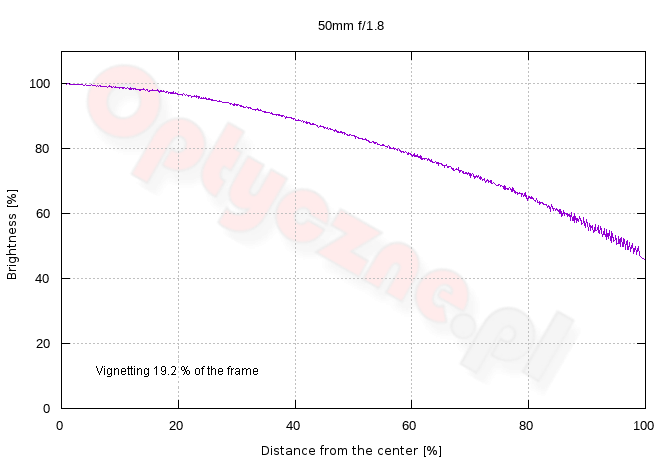Nikon Nikkor Z 50 mm f/1.8 S
8. Vignetting
| Nikon Z7, APS-C/DX, f/1.8 | Nikon Z7, APS-C/DX, f/2.0 |

|

|
On the smaller detector you get some chances to notice vignetting only in the vicinity of the maximum relative aperture. By f/1.8 that aberration reaches a moderate level of 25% (−0.83 EV), by f/2.0 it decreases to 20% (−0.65 EV), and by f/2.8 it becomes practically imperceptible, dropping to a value of 7% (−0.22 EV).
Please Support UsIf you enjoy our reviews and articles, and you want us to continue our work please, support our website by donating through PayPal. The funds are going to be used for paying our editorial team, renting servers, and equipping our testing studio; only that way we will be able to continue providing you interesting content for free. |
- - - - - - - - - - - - - - - - - - - - - - - - - - - - - - - - - - - - - - - - - - - - - - - -
When you progress to the bigger full frame sensor there are more problems and photos below show them pretty well.
| Nikon Z7, FF, f/1.8 | Nikon Z7, FF, f/2.0 |

|

|
| Nikon Z7, FF, f/2.8 | Nikon Z7, FF, f/4.0 |

|

|
At the maximum relative aperture you have to take into account the loss of 53% of light in frame corners (−2.20 EV). Here the tested lens is weaker than its Gauss predecessors and also the Tamron 1.8/45 VC but, at the same time, it fares a bit better than the Sonnar 1.8/55 FE.
When you stop down the aperture to f/2.0 the vignetting decreases to a still distinct level of 48% (−1.89 EV) and it remains completely noticeable also by f/2.8 where we got a result of 29% (−0.99 EV). A low level is achieved only by f/4.0, where that aberration amounts to 17% (−0.55 EV). By f/5.6 you can notice a drop to 16% (−0.52 EV) and further stopping down doesn't have any measurable influence on the aberration, described in this chapter.
Below we present averaged out values of brightness loss shown in concentric circles as you move further away from the frame centre. The numerical value of every image, expressed in percents, shows an area limited from the top and right by 100% and from the bottom by the presented curve. The area indicates how much light overall is lost due to the vignetting effect. Please, don’t mix these percentages with the values given at the beginning of the chapter because they aren’t directly connected







